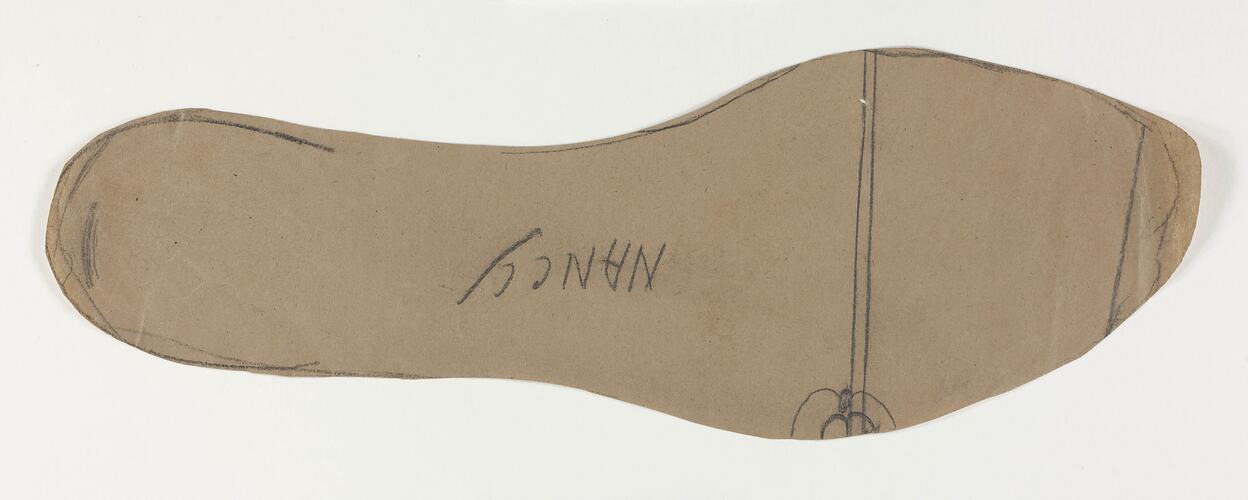Summary
This hand-cut right shoe sole pattern with its various pencil markings and inscriptions has been created on brown paper and was mostly likely used by Stanio Fancoff within the production of his various shoes styles sometime between the 1930s to the 1970s. Accompanying the pencilled lines that are suggestive of a women's sandal, the term "NANCY" has been inscripted possibly indicating this to be one of his particular women's shoe styles. Along with many others, this shoe sole pattern piece was an integral part to Stanio's shoemaking craft and business.
Stanio Ivanoff Fancoff was born in 1908 in Bojentsi, a small village in Bulgaria. At age 11, Stanio left home to learn the shoemaking trade. In 1929, he immigrated to Melbourne, settled in Fitzroy and began to work for the V.G. Zemancheff & Sons basket shoe factory in South Melbourne. In1936, he married Dorotea Georgi Touzou who had recently arrived in Australia. Around this time, Stanio set up his own shoemaking business from home, with Georgi, her cousin and sister weaving the shoes which he then assembled. Select shoe samples were then taken to Sydney and Tasmania for sale. In 1942, Georgi and Stanio moved to Broken Hill for Georgi's health; there daughter Nancy was born and Stanio set up a shoe shop/factory. In 1945, Georgi died and by 1950 Stanio and Nancy had moved to Adelaide where he again opened a shoemaking business and shop. He passed away in 1978, having been in the shoemaking business for 59 years. This collection documents his migration and working life experiences.
Physical Description
This hand-cut right shoe sole pattern with its various pencil markings and inscription has been created on brown paper. On the frontside, the heel and inner footpad areas exhibit pencil lines that mimick their outer edges, while the toe cap area illustrates pencilled lines referencing toe positions. Located within the central footpad area a vertical line cuts across the toe area, while two parallel and closely positioned vertical lines cut across the footpad's midway area to end at the outer edge where a patterned junction point is placed. Furthermore, positioned central to these two lines and approximately 10mm in from their prospective outer edges are two small holes (one on either side). Positioned within the foot arch area the text 'NANCY" is pencil inscribed.
Significance
This collection is significant in documenting a small migrant business as well as the fashion of a particular period. It is well provenanced and charts the application of trade skills in a new country. It also illustrates the stages of hand shoe manufacture from the 1930s, demonstrating the enduring nature of the tools and patterns that were used.
More Information
-
Collecting Areas
-
Acquisition Information
Donation from Nancy Vasileff, 21 Mar 2007
-
Maker
-
Inscriptions
Front, Handwritten, Pencil, Text: NANCY.
-
Classification
-
Category
-
Discipline
-
Type of item
-
Overall Dimensions
85 mm (Width), 252 mm (Height)
-
References
R.A. Salaman, 'Dictionary of Leather-working Tools c.1700-1950 and Tools of Allied Trades,' London: George Allen and Unwin (Publishers) Ltd, 1986 [Section 2: Boot and Shoe Maker pp18-185]. John Peacock. 'Shoes, The Complete Sourcebook,' London:Thames & Hudson Ltd, 2005. NAA holds file (online) on Vasil George Zemancheff, Fancoff's employer
-
Keywords
Boot & Shoemaking, Bulgarian Communities, Bulgarian Immigration, Immigration, Small Businesses



